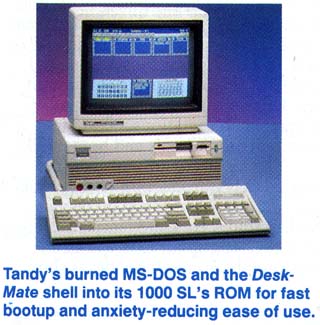REVIEWS
 Tandy
1000 SL
Tandy
1000 SLThere's no great art to building an IBM PC XT compatible. It's a sophisticated but commonplace occurrence in factories from Maine to Malaysia. But anyone who carefully reads the ads in computer magazines soon realizes that not all machines are created equal. Tandy obviously came to the same conclusion and raised the stakes with its new 1000 SL. Here's a computer loaded with features, priced for the home, and ready to use right out of the box.

The 1000 SL is built around an 8086 chip, with a software-selectable speed of 4 or 8 MHz. The system box measures 15½ inches wide X 5½ inches tall X 13 inches long and weighs 11 pounds-you'll need something bigger than a student's desk to set it on. The box houses one 5¼-inch 360K disk drive, with room for a second disk drive or a hard disk; five 8-bit expansion slots that will take PC XT-compatible boards; one RS-232 serial (to connect a mouse or a modem, for example) and one parallel port; 384K of RAM, expandable to 640K on the main board; 512K of ROM; and 1024 bits of EEPROM for system configuration.
It's the EEPROM and ROM that separate this computer from its clone cousins. Barring fly-by-night XT mak ers, there's little to differentiate one XT compatible from another. Many are reliable, most work the same way, and all boast roughly the same features while adhering to the MS-DOS standards. Tandy goes further by burning those standards into the hardware. It's an important decision, and users benefit by getting a faster, simpler, more efficient computer.
When you switch on the 1000 SL, the EEPROM is set to take you to Tandy's DeskMate graphics interface, a shell for the company's integrated software program. (The DeskMate program itself comes on four disks.) It takes about 11 seconds for the shell to come up. If you don't want to go to the DeskMate shell, you can easily change the EEPROM configuration to display the A> prompt (practically instantaneous), or to boot from a disk.
Besides the DeskMate shell, the Tandy's ROM includes a spelling checker and some oft-used MS-DOS 3.3 utilities like FORMAT and DISKCOPY. The rest of the operating system and GW-BASIC come on two disks.
The SL's 101-key enhanced keyboard has 12 function keys at the top and a comfortably angled bed. Tandy could improve on the key play, however. The travel is fine, but the action is soft and slightly deadened. You may feel different, but I prefer a hard click under my fingers.
This computer is much quieter than the now-obsolete 1000 EX I have at home. The on/off switch is in the front, next to the top disk drive, and is easy to get to. The volume control, on the left front at the bottom, isn't as convenient, especially if your keyboard is butted up against the CPU. The red reset button on the front is a lot better than the old Control-Alt-Delete fingerstretching, wrist-twisting manual reset.
There are some other features that will make the SL appealing to home computer users. Built-in enhanced CGA support means you won't have to spend extra for a graphics board to get 16-color or high-resolution monochrome display. Two joystick ports with built-in joystick support save you more money and make gaming a blast. A three-voice sound chip and an analogto-digital/digital-to-analog converter let you record to and play from disk. A built-in speaker, microphone and earphone jacks, and sophisticated sound and music editing/composing software let users experiment right away without investing in expensive MIDI systems.
I got a real kick out of the music program. Tandy has included four songs that you can play (from Bach to a Christmas medley). If you're a budding composer, you can write your own songs and print the scores on a laser or dot-matrix printer. You can edit, transpose, and play your compositions at the touch of a button. It'll take some time to learn how to do all of this, but you can be playing the included tunes within five minutes of opening the box.
The 1000 SL doesn't come with a monitor, but Tandy sometimes offers a discount on its CM-5 or CM-11 color monitor when you bundle it with a computer. I reviewed the SL with the CM-11, and I have a CM-5 at home. The CM-11 displays great hi-res graphics, and the CM-5 offers super color as well-both support Tandy's 16-color palette. If you keep your eyes peeled for a Radio Shack sale, you can pick up a plug-and-play SL color system (no printer) for about $1,100.
A lot of computer magazines say you need the power of an IBM PC AT or compatible if you want to compute in the MS-DOS world. But word processing, family budgets, home inventories, games, graphics, telecommunications, music, and almost any task you can imagine are possible on the XT and even PC level. And few computers go as far as the 1000 SL in putting that capability right in your hands, right out of the box, right now.
-
Peter Scisco
| Tandy 1000 SL For... $899 From ...
Tandy/Radio Shack
1700 One Tandy Center Fort Worth, TX 76102 (817) 390-3011 And... CM-5 color monitor-$299.95
CM-11 color monitor-$399.95 |